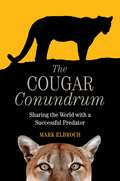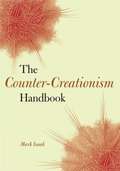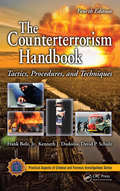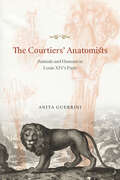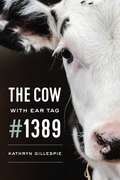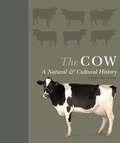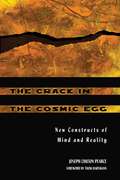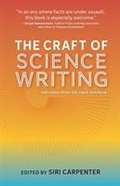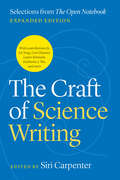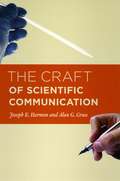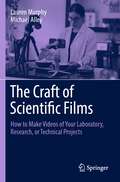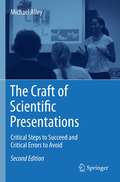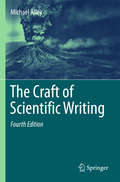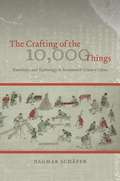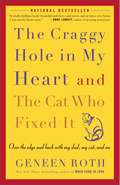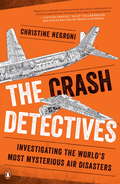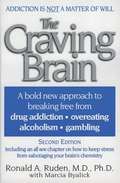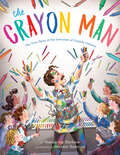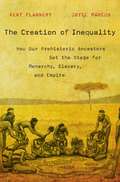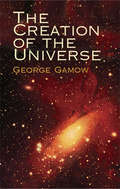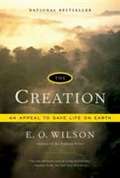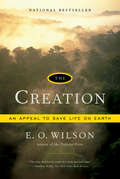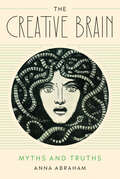- Table View
- List View
The Cougar Conundrum: Sharing the World with a Successful Predator
by Mark ElbrochThe relationship between humans and mountain lions has always been uneasy. A century ago, mountain lions were vilified as a threat to livestock and hunted to the verge of extinction. In recent years, this keystone predator has made a remarkable comeback, but today humans and mountain lions appear destined for a collision course. Its recovery has led to an unexpected conundrum: Do more mountain lions mean they're a threat to humans and domestic animals? Or, are mountain lions still in need of our help and protection as their habitat dwindles and they're forced into the edges and crevices of communities to survive? Mountain lion biologist and expert Mark Elbroch welcomes these tough questions. He dismisses long-held myths about mountain lions and uses groundbreaking science to uncover important new information about their social habits. Elbroch argues that humans and mountain lions can peacefully coexist in close proximity if we ignore uninformed hype and instead arm ourselves with knowledge and common sense. He walks us through the realities of human safety in the presence of mountain lions, livestock safety, competition with hunters for deer and elk, and threats to rare species, dispelling the paranoia with facts and logic. In the last few chapters, he touches on human impacts on mountain lions and the need for a sensible management strategy. The result, he argues, is a win-win for humans, mountain lions, and the ecosystems that depend on keystone predators to keep them in healthy balance. The Cougar Conundrum delivers a clear-eyed assessment of a modern wildlife challenge, offering practical advice for wildlife managers, conservationists, hunters, and those in the wildland-urban interface who share their habitat with large predators.
The Counter-Creationism Handbook
by Mark IsaakIsaak, editor of the Index of Creationist Claims on the Web site Talkorigins.org, notes that arguments for intelligent design and other creationist pseudoscience often sound powerful and convincing; many students, teachers, parents, and administrators who support the teaching of evolution lack the background to respond. Isaak's guide hands them that background, taking on claims made about the disciplines of philosophy, biology, paleontology, geology, astronomy, physics and mathematics, history, linguistics, and folklore. The material is organized thematically, with extensive cross-referencing. Some 400 claims are included, each followed by a succinct and valid scientific rebuttal. An introduction covers how to address creationism in different venues and why accurate science is important. Annotation ©2005 Book News, Inc., Portland, OR (booknews.com)
The Counterterrorism Handbook: Tactics, Procedures, and Techniques, Fourth Edition (ISSN)
by David P. Schulz Frank Bolz, Jr. Kenneth J. DudonisTerrorists constantly present new challenges to law enforcement, emergency response teams, security planners, and others involved in counterterrorism. Since the last edition of this volume was published, additional atrocities have occurred and new threats have surfaced. The fourth edition of The Counterterrorism Handbook: Tactics, Procedures, and Techniques provides the latest developments and offers new insights on the War on Terror.Updated to reflect an increased focus on terrorism in public transportation, this volume provides an understanding of the strategies, tactics, and techniques required to tackle terrorism as it exists today. It illustrates essential topics such as the elements common to all terrorism, bomb threats, risk assessment, hostages, and weapons of mass destruction. It also presents case studies of some of the most notorious terrorist incidents, including both World Trade Center attacks, Oklahoma City, Centennial Olympic Park, the U.S. Embassy, the U.S.S. Cole, and attacks in Madrid, London, and Glasgow.The only way to effectively deal with terrorism is to have a thorough understanding of its present-day characteristics — who is involved and what weapons and tactics they are likely to use. In language friendly to first responders, this volume presents a comprehensive strategy of how to deal with a whole gamut of possible terrorist incidents. Covering everything from bombings and hostage-taking to nuclear terrorism, the book describes in specific detail what needs to be done before, during, and after an event. Armed with this information, those charged with protecting the public will be better equipped to face myriad threats.
The Courtiers' Anatomists: Animals and Humans in Louis XIV's Paris
by Anita Guerrini"The Courtiers' Anatomists" is about dead bodies and live animals in Louis XIV's Paris--and the surprising links between them. Examining the practice of seventeenth-century anatomy, Anita Guerrini reveals how anatomy and natural history were connected through animal dissection and vivisection. Driven by an insatiable curiosity, Parisian scientists, with the support of the king, dissected hundreds of animals from the royal menageries and the streets of Paris. Guerrini is the first to tell the story of Joseph-Guichard Duverney, who performed violent, riot-inducing dissections of both animal and human bodies before the king at Versailles and in front of hundreds of spectators at the King's Garden in Paris. At the Paris Academy of Sciences, meanwhile, Claude Perrault, with the help of Duverney s dissections, edited two folios in the 1670s filled with lavish illustrations by court artists of exotic royal animals. Through the stories of Duverney and Perrault, as well as those of Marin Cureau de la Chambre, Jean Pecquet, and Louis Gayant, "The Courtiers' Anatomists" explores the relationships between empiricism and theory, human and animal, as well as the origins of the natural history museum and the relationship between science and other cultural activities, including art, music, and literature. "
The Cow with Ear Tag #1389
by Kathryn GillespieTo translate the journey from a living cow to a glass of milk into tangible terms, Kathryn Gillespie set out to follow the moments in the life cycles of individual animals—animals like the cow with ear tag #1389. She explores how the seemingly benign practice of raising animals for milk is just one link in a chain that affects livestock across the agricultural spectrum. Gillespie takes readers to farms, auction yards, slaughterhouses, and even rendering plants to show how living cows become food. The result is an empathetic look at cows and our relationship with them, one that makes both their lives and their suffering real.
The Cow: A Natural and Cultural History
by Professor Catrin RutlandA richly illustrated introduction to the science and history of the cowWe populate the countryside with cows the world over, and their familiar presence ensures that global demands for milk and beef are met. But with more than a billion cattle on the planet, the importance of cows extends well beyond food production. Cows are venerated by some religions and shunned by others; they provide leather for shoes, clothing, and other uses; and they have long been central to the agricultural way of life, working the fields, pulling carts, and providing fertilizer. The Cow is a comprehensive guide to help us understand these important animals, offering a wealth of information about their anatomy and behaviors, breed varieties, and place in human culture past and present. Exploring the cow’s livestock credentials and beyond, this book combines engaging and informative text, beautiful photographs, and explanatory diagrams to examine the cow's fascinating biology, its hard-wired behaviors, and its relationship with humankind.Provides an in-depth look at the evolution of the cow, its role in agriculture, and the development of breedsIncludes chapters on Anatomy & Biology, Society & Behavior, and Cattle & PeopleFeatures a photographic directory of forty global cattle breeds
The Crab Alphabet Book
by Jerry PallottaWith his signature humor and amazing facts, best-selling author Jerry Pallotta offers a decapod for every letter of the alphabet.Meet dozens of crustaceans--and a few bonus animals--with engaging text and a laugh-out-loud narrative, from A (Arrow Crab) to E (exoskeleton) to I (Imocaris, a kind of fossil scientists believe to be the first crab on earth) to Z (Zebra Hermit Crabs, which have a hard covering on their legs and claws, but their body is soft). Readers of all ages will be entertained (and learning!) with every page turn.
The Crack in the Cosmic Egg: New Constructs of Mind and Reality
by Thom Hartmann Joseph Chilton PearceThe classic work that shaped the thought of a generation with its powerful insights into the true nature of mind and reality. • Defines culture as a "cosmic egg" structured by the mind's drive for logical ordering of its universe. • Provides techniques allowing individuals to break through the vicious circle of logic-based systems to attain expanded ways of creative living and learning. The sum total of our notions of what the world is--and what we perceive its full potential to be--form a shell of rational thought in which we reside. This logical universe creates a vicious circle of reasoning that robs our minds of power and prevents us from reaching our true potential. To step beyond that circle requires a centering and focus that today's society assaults on every level. Through the insights of Teilhard, Tillich, Jung, Jesus, Carlos Castaneda, and others, Joseph Chilton Pearce provides a mode of thinking through which imagination can escape the mundane shell of current construct reality and leap into a new phase of human evolution. This enormously popular New Age classic is finally available again to challenge the assumptions of a new generation of readers and help them develop their potential through new creative modes of thinking. With a masterful synthesis of recent discoveries in physics, biology, and psychology, Pearce reveals the extraordinary relationship of mind and reality and nature's blueprint for a self-transcending humanity.
The Craft of Science Writing: Selections from The Open Notebook
by Siri CarpenterThis book is a collection of indispensable articles on the craft of science writing as told by some of the most skillful science journalists working today. These selections are a wealth of journalistic knowledge from The Open Notebook, the online community that has been a primary resource for science journalists and aspiring science writers for the last decade. The Craft of Science Writing gives you a crew of accomplished, encouraging friends to whisper over your shoulder as you work. In these pages, you'll find interviews with leading journalists offering behind-the-scenes inspiration, as well as in-depth essays on the craft offering practical advice.
The Craft of Science Writing: Selections from “The Open Notebook,” Expanded Edition (Chicago Guides to Writing, Editing, and Publishing)
by Siri CarpenterA deeply sourced, inclusive guide to all aspects of science writing with contributions from some of the most skilled and award-winning authors working today. Science writing has never been so critical to our world, and the demands on writers have never been greater. On any given day, a writer might need to explain the details of AI, analyze developments in climate change research, or serve as a watchdog helping to ensure the integrity of the scientific enterprise. At the same time, writers must spin tales that hook and keep readers, despite the endless other demands on their attention. How does one do it? The Craft of Science Writing is the authoritative guide. With pieces curated from the archives of science writers’ go-to online resource, The Open Notebook, this book explores strategies for finding and shaping story ideas, pitching editors, and building a specialty in science writing. It delves into fundamental skills that every science writer must learn, including planning their reporting; identifying, interviewing, and quoting sources; organizing interview notes; and crafting stories that engage and inform audiences. This expanded edition includes new introductory material and nine new essays focusing on such topics as how to establish a science beat, how to find and use quotes, how to critically evaluate scientific claims, how to use social media for reporting, and how to do data-driven reporting. In addition, there are essays on inclusivity in science writing, offering strategies for eradicating ableist language from stories, working with sensitivity readers, and breaking into English-language media for speakers of other languages. Through interviews with leading journalists offering behind-the-scenes inspiration as well as in-depth essays on the craft offering practical advice, readers will learn how the best science stories get made, from conception to completion. Contributors: Humberto Basilio, Siri Carpenter, Jeanne Erdmann, Dan Ferber, Tina Casagrand Foss, Geoffrey Giller, Laura Helmuth, Jane C. Hu, Alla Katsnelson, Roxanne Khamsi, Betsy Ladyzhets, Jyoti Madhusoodanan, Amanda Mascarelli, Robin Meadows, Kate Morgan, Tiên Nguyễn, Michelle Nijhuis, Aneri Pattani, Rodrigo Pérez Ortega, Mallory Pickett, Kendall Powell, Tasneem Raja, Sandeep Ravindran, Marion Renault, Julia Rosen, Megha Satyanarayana, Christina Selby, Knvul Sheikh, Abdullahi Tsanni, Alexandra Witze, Katherine J. Wu, Wudan Yan, Ed Yong, Rachel Zamzow, Sarah Zhang, and Carl Zimmer
The Craft of Scientific Communication (Chicago Guides To Writing, Editing, And Ser.)
by Alan G. Gross Joseph E. HarmonThe ability to communicate in print and person is essential to the life of a successful scientist. But since writing is often secondary in scientific education and teaching, there remains a significant need for guides that teach scientists how best to convey their research to general and professional audiences. The Craft of Scientific Communication will teach science students and scientists alike how to improve the clarity, cogency, and communicative power of their words and images.In this remarkable guide, Joseph E. Harmon and Alan G. Gross have combined their many years of experience in the art of science writing to analyze published examples of how the best scientists communicate. Organized topically with information on the structural elements and the style of scientific communications, each chapter draws on models of past successes and failures to show students and practitioners how best to negotiate the world of print, online publication, and oral presentation.
The Craft of Scientific Films: How to Make Videos of Your Laboratory, Research, or Technical Projects
by Michael Alley Lauren MurphyThis book, the first of its kind, helps scientists and engineers of all stages and disciplines share their work in a new way—with movies. Today, much of scientific communication is embedded in papers and presentations, but these documents don’t often extend outside of a specific academic field. By adding movies as a medium of communication, scientists and engineers can better communicate with their colleagues while also increasing their reach to students, professors, peers, potential collaborators, and the public. Scientific films help translate complex technical topics into more accessible and consumable messages. By following Lauren Murphy’s filmmaking formula – planning, shooting, and editing – readers will create their very own scientific films that look professional and polished. Using tools as simple as a smartphone, readers can develop short, personal stories with no cost or experience needed. This book will guide readers through all steps of the movie making process to a finished product. Readers will evolve their creative thinking skills and use their movies to improve classroom presentations, network across student organizations, present at conferences, recruit students for their labs, secure grant money, and more. Adding a movie to your body of work can be the tool that sparks interest in audiences to learn more—driving traffic to your publications, research projects, and websites. This book will help you develop new skills to become a better communicator while spreading your ideas and research to new audiences.
The Craft of Scientific Presentations: Critical Steps to Succeed and Critical Errors to Avoid
by Michael AlleyThe Craft of Scientific Presentations, 2nd edition aims to strengthen you as a presenter of science and engineering. The book does so by identifying what makes excellent presenters such as Brian Cox, Jane Goodall, Richard Feynman, and Jill Bolte Taylor so strong. In addition, the book explains what causes so many scientific presentations to flounder. One of the most valuable contributions of this text is that it teaches the assertion-evidence approach to scientific presentations. Instead of building presentations, as most engineers and scientists do, on the weak foundation of topic phrases and bulleted lists, this assertion-evidence approach calls for building presentations on succinct message assertions supported by visual evidence. Unlike the commonly followed topic-subtopic approach that PowerPoint leads presenters to use, the assertion-evidence approach is solidly grounded in research. By showing the differences between strong and weak presentations, by identifying the errors that scientific presenters typically make, and by teaching a much more powerful approach for scientific presentations than what is commonly practiced, this book places you in a position to elevate your presentations to a high level. In essence, this book aims to have you not just succeed in your scientific presentations, but excel. About the Author Michael Alley has taught workshops on presentations to engineers and scientists on five continents, and has recently been invited to speak at the European Space Organization, Harvard Medical School, MIT, Sandia National Labs, Shanghai Jiao Tong University, Simula Research Laboratory, and United Technologies. An Associate Professor of engineering communication at Pennsylvania State University, Alley is a leading researcher on the effectiveness of different designs for presentation slides.
The Craft of Scientific Writing
by Michael AlleyThe Craft of Scientific Writing is designed to help scientists and engineers - both professionals already active in the disciplines as well as students preparing to enter the professions - write about their work clearly and effectively. Written for use as a text in courses on scientific writing, the book includes many useful suggestions about approaching a wide variety of writing tasks from journal papers to grant proposals and from emails to formal reports, as well as a concise guide to style and usage appropriate for scientific writing. Also useful for self-study, the book will be an important reference for all scientists and engineers who need to write about their work. With this new and updated fourth edition, while most technical writing texts have gotten larger over the years, this one has streamlined, to provide busy readers with the essence of what distinguishes the style of the best scientific documents. With this new edition, readers will learn not just how to organize information, but how to emphasize the key details of that information. Also, readers will not just learn how to cast their ideas into precise and clear sentences, but how to connect these sentences in an energetic fashion. In the section on language, the new edition goes into much depth about how to make connections between ideas: an important issue that few technical writing texts address. Moreover, the new edition integrates the discussion of illustrations with language because those two aspects of style are so intertwined. Finally, the new edition does a better job of explaining how to make the process of writing more efficient. From a review of the first edition: "A refreshing addition to a genre dominated by English teacher-style textbooks. Instead of listing rules that constrain writers, the book uses examples to lay out the path to successful communication … Especially helpful (and entertaining) is the chapter on the writing process. Anyone who has spent more time avoiding a writing task than actually doing it will appreciate Alley's tips." –Dr. Ellen Ochoa, Deputy Director of Flight Crew Operations, Johnson Space Center
The Crafting of the 10,000 Things: Knowledge and Technology in Seventeenth-Century China
by Dagmar SchäferThe last decades of the Ming dynasty, though plagued by chaos and destruction, saw a significant increase of publications that examined advances in knowledge and technology. Among the numerous guides and reference books that appeared during this period was a series of texts by Song Yingxing (1587–1666?), a minor local official living in southern China. His Tiangong kaiwu, the longest and most prominent of these works, documents the extraction and processing of raw materials and the manufacture of goods essential to everyday life, from yeast and wine to paper and ink to boats, carts, and firearms. In The Crafting of the 10,000 Things, Dagmar Schäfer probes this fascinating text and the legacy of its author to shed new light on the development of scientific thinking in China, the purpose of technical writing, and its role in and effects on Chinese history. Meticulously unfolding the layers of Song’s personal and cultural life, Schäfer chronicles the factors that motivated Song to transform practical knowledge into written culture. She then examines how Song gained, assessed, and ultimately presented knowledge, and in doing so articulates this era’s approaches to rationality, truth, and belief in the study of nature and culture alike. Finally, Schäfer places Song’s efforts in conjunction with the work of other Chinese philosophers and writers, before, during, and after his time, and argues that these writings demonstrate collectively a uniquely Chinese way of authorizing technology as a legitimate field of scholarly concern and philosophical knowledge. Offering an overview of a thousand years of scholarship, The Crafting of the 10,000 Things explains the role of technology and crafts in a culture that had an outstandingly successful tradition in this field and was a crucial influence on the technical development of Europe on the eve of the Industrial Revolution.
The Craggy Hole in My Heart and the Cat Who Fixed It: Over the Edge and Back with My Dad, My Cat, and Me
by Geneen RothIn this inspiring and joyous book,New York Times bestselling author Geneen Roth introduces her remarkable twenty-pound cat, Mister Blanche, and her beloved father, Bernard, as she takes readers deep into the story of how each finally taught her to love without reservation and accept that she might someday lose those whom she believed she couldn't live without. Told with warmth and wit, The Craggy Hole in My Heart and The Cat Who Fixed It is a poignant and funny story about how to live with love--and never live without it.
The Crash Detectives: Investigating the World's Most Mysterious Air Disasters
by Christine Negroni"Negroni is a talented aviation journalist who clearly understands the critically important part the human factor plays in aviation safety." --Captain Chesley "Sully" Sullenberger, pilot of US Airways 1549, the Miracle on the HudsonOne of The Wall Street Journal's 3 Books Every Geek Should Read This FallA fascinating exploration of how humans and machines fail--leading to air disasters from Amelia Earhart to MH370--and how the lessons learned from these accidents have made flying safer. In The Crash Detectives, veteran aviation journalist and air safety investigator Christine Negroni takes us inside crash investigations from the early days of the jet age to the present, including the search for answers about what happened to the missing Malaysia Airlines Flight 370. As Negroni dissects what happened and why, she explores their common themes and, most important, what has been learned from them to make planes safer. Indeed, as Negroni shows, virtually every aspect of modern pilot training, airline operation, and airplane design has been shaped by lessons learned from disaster. Along the way, she also details some miraculous saves, when quick-thinking pilots averted catastrophe and kept hundreds of people alive. Tying in aviation science, performance psychology, and extensive interviews with pilots, engineers, human factors specialists, crash survivors, and others involved in accidents all over the world, The Crash Detectives is an alternately terrifying and inspiring book that might just cure your fear of flying, and will definitely make you a more informed passenger."Christine Negroni combines her investigative reporting skills with an understanding of the complexities of air accident investigations to bring to life some of history's most intriguing and heartbreaking cases." --Bob Woodruff, ABC News From the Trade Paperback edition.
The Craving Brain: A Bold New Appraoch to Breaking Free from Drug Addiction, Overeating, Alcoholism, Gambling (Second Edition)
by Marcia Byalick Ronald A. RudenIn the Craving Brain, Dr. Ronald Ruden asserts that the roots of addiction most definitely do not lie in our character. Rather, they lie in a complex chain reaction that originates in an ancient survival mechanism in the brain. When this system is inappropriately activated, it drives the body to crave, sometimes with addictive behavior as the end result. In clear, straightforward language, Dr. Ruden outlines his remarkable successful treatment program which he believes can cure this problem. The Craving Brain offers crucial insights into the world of addiction. This revolutionary book will bring hope to millions of people who suffer from a wide range of addictions, from gambling and alcohol to drugs and food.
The Crayon Man: The True Story of the Invention of Crayola Crayons
by Natascha BiebowCelebrating the inventor of the Crayola crayon! This gloriously illustrated picture book biography tells the inspiring story of Edwin Binney, the inventor of one of the world's most beloved toys. A perfect fit among favorites like The Day the Crayons Quit and Balloons Over Broadway.purple mountains&’ majesty, mauvelous, jungle green, razzmatazz… What child doesn't love to hold a crayon in their hands? But children didn't always have such magical boxes of crayons. Before Edwin Binney set out to change things, children couldn't really even draw in color. Here&’s the true story of an inventor who so loved nature&’s vibrant colors that he found a way to bring the outside world to children – in a bright green box for only a nickel! With experimentation, and a special knack for listening, Edwin Binney and his dynamic team at Crayola created one of the world&’s most enduring, best-loved childhood toys – empowering children to dream in COLOR!
The Creation of Inequality: How Our Prehistoric Ancestors Set the Stage for Monarchy, Slavery, and Empire
by Kent Flannery Joyce MarcusOur early ancestors lived in small groups and worked actively to preserve social equality. As they created larger societies, however, inequality rose, and by 2500 BCE truly egalitarian societies were on the wane. In The Creation of Inequality, Kent Flannery and Joyce Marcus demonstrate that this development was not simply the result of population increase, food surplus, or the accumulation of valuables. Instead, inequality resulted from conscious manipulation of the unique social logic that lies at the core of every human group. A few societies allowed talented and ambitious individuals to rise in prestige while still preventing them from becoming a hereditary elite. But many others made high rank hereditary, by manipulating debts, genealogies, and sacred lore. At certain moments in history, intense competition among leaders of high rank gave rise to despotic kingdoms and empires in the Near East, Egypt, Africa, Mexico, Peru, and the Pacific. Drawing on their vast knowledge of both living and prehistoric social groups, Flannery and Marcus describe the changes in logic that create larger and more hierarchical societies, and they argue persuasively that many kinds of inequality can be overcome by reversing these changes, rather than by violence.
The Creation of the Universe
by George Gamow"Fascinating. . . . Distinctly readable and highly informative." -- San Francisco Chronicle.Since time immemorial, people have attempted to explain the origin of the world, from the creation myths of the ancients to the more sophisticated views that developed with the progress of observational astronomy. This lively and authoritative survey by an internationally famous physicist and one of the formulators of the Big Bang theory of cosmology offers captivating perspectives on the births of the galaxies, stars, chemical elements, and planetary systems.The author of such popular books as One Two Three . . . Infinity, George Gamow has introduced millions of readers to the concepts of relativity, atomic and nuclear physics, and other scientific subjects. Illustrated with diagrams and Gamow's own drawings, this remarkably accessible book explains complex and difficult concepts in a direct and simple manner, with minimal references to mathematics. The Creation of the Universe addresses both the Big Bang and Steady State theories of cosmogony, and is equally suitable for scientists from every field, as well as nonspecialists. Preface. Appendix. Index. 40 figures.
The Creation: An Appeal to Save Life on Earth
by Edward O. WilsonIn this daring work, Edward O. Wilson proposes an alliance between science and religion to save Earth's vanishing biodiversity.
The Creation: An Appeal to Save Life on Earth
by Edward O. WilsonThe book that launched a movement: "Wilson speaks with a humane eloquence which calls to us all" (Oliver Sacks). Called "one of the greatest men alive" by The Times of London, E. O. Wilson proposes an historic partnership between scientists and religious leaders to preserve Earth's rapidly vanishing biodiversity.
The Creationists
by Ronald M. NumbersNumbers' examination of the English-speaking Christians, primarily North American, who believe that there was no life on earth before Eden--less than ten thousand years ago--with an emphasis on how persons and parties have used "science" and "pseudoscience" to further their ends.
The Creative Brain: Myths and Truths
by Anna AbrahamA nuanced, science-based understanding of the creative mind that dispels the pervasive myths we hold about the human brain—but also uncovers the truth at their cores.What is the relationship between creativity and madness? Creativity and intelligence? Do psychedelics truly enhance creativity? How should we understand the left and right hemispheres of the brain? Is the left brain, in fact, the seat of reasoning and the right brain the seat of creativity? These are just some of the questions Anna Abraham, a renowned expert of human creativity and the imagination, explores in The Creative Brain, a fascinating deep dive into the origins of the seven most common beliefs about the human brain. Rather than endorse or debunk these myths, Abraham traces them back to their origins to explain just how they started and why they spread—and what at their core is the truth.Drawing on theoretical and empirical work in cognitive psychology and neuroscience, Abraham offers an examination of human creativity that reveals the true complexity underlying our conventional beliefs about the brain. The chapters in the book explore the myth of the right brain as the hemisphere responsible for creativity; the relationship between madness and creativity, psychedelics and creativity, atypical brains and creativity, and intelligence and creativity; the various functions of dopamine; and lastly, the default mode revolution, which theorized that the brain regions most likely to be involved in the creative process are those areas of the brain that are most active during rest or mind-wandering.An accessible and engaging read, The Creative Brain gets to the heart of how our creative minds work and why some people are more creative than others, offering illuminating insights into what on its surface seems to be an endlessly magical phenomenon.
